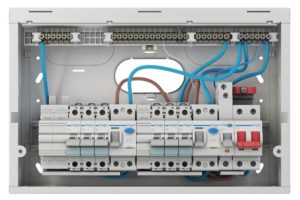Type AC residual current protection has been applied in UK domestic premises, with little consideration for the nature of appliances and loads connected downstream of the RCD. The impact of increased leakage currents can result in unwanted tripping, which results in other safety complications – loss of lighting and supplies for essential equipment. The 18th Edition addresses these issues and the selection of Types of RCD as applicable to the revised regulations.
Regulation 531.3.2 deals with unwanted tripping and the requirements for reliable performance. Regulation 531.3.3 covers the selection of different Types of RCD, based on the type of residual current and applies to all installations.
Why should we improve safety in Electrical Installations?
Electrical Safety First highlight that far greater demands are placed on domestic electrical installations than at any time, with more electrical appliances per head and increased complexity leading to increased risk of electrical accidents…” Government statistics show that electricity causes more than 20,000 fires a year – almost half of all accidental UK house fires. Each year, about 70 people are killed and 350,000 are seriously injured due to an electrical accident in the home”. In their words…” It’s easy to make an electrical circuit work – it’s far harder to make the circuit work safely “
RCD selection: What the 18th Edition Regulations say
Regulation 531.3 (formally 531.2) covers the selection of RCDs for fault protection by automatic disconnection of the supply. There are several changes in this section giving more detailed requirements and advise on selection of RCDs to improve the quality and safety of domestic installations.
531.3.2 Unwanted tripping
LED lighting, PCs, TV power supplies i.e. any equipment containing capacitors (just about everything these days) produce higher leakage currents than conventional loads we had in our old homes. Customers should be advised of the possibility of unwanted tripping, where too many appliances are connected downstream of one RCD. Examples are given in Table 1 below.
Allow for the reliable provision of lighting circuits in all installations and any medical equipment for home treatment/diagnostics, stair lifts etc. (see See 314 Division of Installation). Domestic Lighting Circuits must now incorporate RCD protection <30 mA – see Regulation 411.3.4.

RCD protected circuits: Consider any earth leakage current likely to occur in normal operation, to reduce the chance of unwanted tripping – see comments page 2.
(i) The sum of the leakage currents shall not exceed 30% of the RCD residual current.
Note 2 Reminds us that RCDs are designed to trip if the residual current is > 50% IΔn
(ii) Short time-delayed* transient resistant 30 mA RCDs with 5 x IΔn <40 ms characteristic can be used to reduce unwanted tripping associated with capacitors charging in power supplies.
*Not to be confused with Selective / Timed delay RCDs which are not suitable for 30 mA applications.
Equipment with leakage currents > 3.5 < 10 mA must be permanently connected see 543.7.1.201.
531.3.3 Types of RCD
This Regulation specifies the different Types of RCD based on their ability to deal with various types of residual current.
The appropriate RCD shall be selected from the following Type: AC, A, F or B, See Table 2 below for a summary of the RCD characteristics given in 531.3.3.
Note: Type EV is related to Reg. 722.531.2.101 for car charging installations, not for inclusion in Domestic Consumer units.
Appliances including certain types of washing machine, induction hobs, LED lighting, power supplies for TV, PC and AV equipment, speed control on pumps etc. can produce residual currents that are not compatible with type AC RCDs.

Incorporating these requirements into consumer units
Most equipment using single phase SWM power supplies e.g. PCs, TVs, game consoles, LED lamps should be suitable for use with Type A RCDs. Some equipment mainly related to kitchens and or utility rooms is designed for connection to circuits protected by Type F RCDs. These appliances are becoming more common as older appliances are replaced with energy efficient ones. This is likely to have a greater impact on New Builds, where appliances are supplied as part of the fixtures and fittings. The House Builder is also responsible for the electrical specification and installation certificates for each property. What are the risks if you use Type A instead of Type F; residual currents generated by the equipment <1kHz cannot be detected and they may also result in the RCD overheating / non-tripping for 50Hz residual currents.
For lighting circuits incorporating LED lamps, consider the individual LED driver’s inrush current and leakage current. The high transient currents that flow when the LED drivers are powered up (typically 50 -80 x Lamp current), may cause unwanted tripping if there are too many lamps on 1 circuit (standard RCDs – maximum 250A 8/20μs). If this is likely to be an issue, restrict the number of lamps per circuit or use transient resistant RCD such as Type AKV or Type F – see table 2. The Leakage current is harder to determine as it will be linked to the type of fitting, type of lamp and the location e.g. in a bathroom or other humid environments. These two areas require practical experience and advice from the LED lamp manufacturers, to help installers design reliable lighting installations, when associated with 30mA RCD protected circuits.

Design for safe and reliable operation
In a modern installation, it is unlikely that Type AC RCDs can be used safely, unless the circuit is restricted to the use of general purpose equipment, such as resistive heating and lighting loads. The example consumer unit contains a single module Type A RCBO for lighting circuit with room for other RCBOs, alarm circuits etc. Type F RCCB protected circuits for kitchens, utility rooms, plus any other circuits and Type A RCCB for circuits supplying family rooms and bedrooms, in line with the requirements of the 18th Edition Regulations.
Source: https://www.voltimum.co.uk/articles/consumer-units-and-rcds-18th-edition-bs




